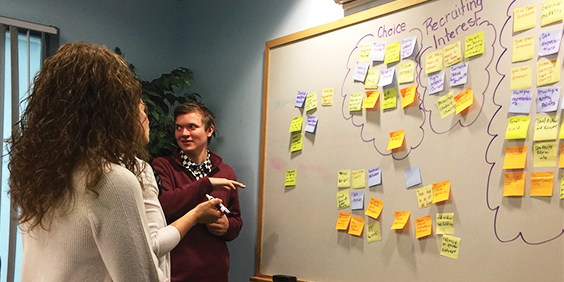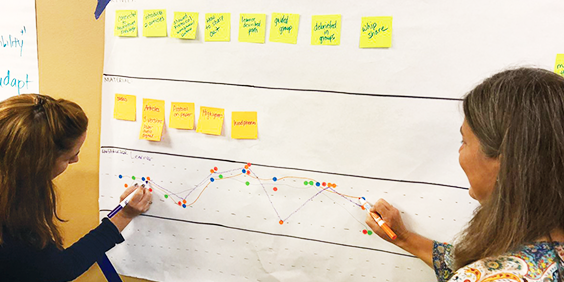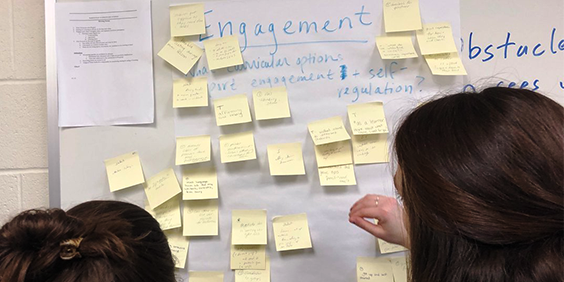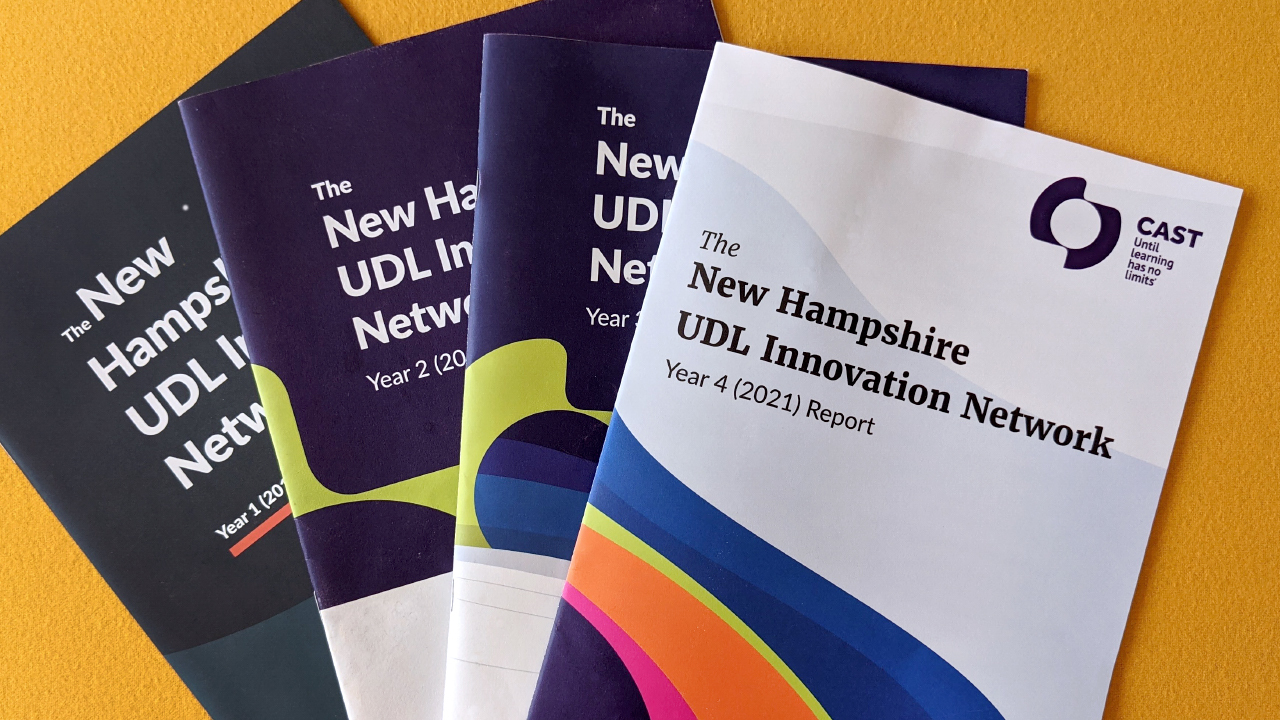Written by Mary Donovan, Robin Gregg, Emily Hartshorne, Molly Moore Lazar, Katie Page, Carole Storro, Christopher Stulz, and Stephanie Syre-Hager of the Antrim Elementary School in New Hampshire
In her role as principal of a small rural elementary school in New England, Stephanie Syre-Hager began a quest to create a more inclusive environment for the students in her school, as well as build the expertise of teachers to engage all students and create the foundation for expert learning. That quest manifested itself in the Antrim Elementary School staff exploring Universal Design for Learning (UDL) for the past four years through their participation in the New Hampshire UDL Innovation Network. Starting with a small “seed group” of interested teachers who quickly became committed to UDL, this work has now blossomed to include the entire AES staff. Despite the challenges of the pandemic, they continue on a forward-moving journey to increase their professional knowledge and move toward full implementation of UDL to support student learning.
The First Year: Learning UDL Basics
During the first year, an initial group of five AES staff members began to explore UDL by attending UDL Network meetings and working with the school’s CAST implementation specialist, Bill Wilmot. They learned the basics of UDL and readily saw the potential of what a truly inclusive setting could do to benefit all students. They deepened their UDL knowledge through professional development, and they learned about and participated in Instructional Rounds, which gave educators the opportunity to observe in other classrooms and reflect on that experience. Instructional Rounds is a process modeled after medical grand rounds, whereby groups of educators visit classrooms, observe teaching and learning, and discuss successes and shortcomings. Harvard Graduate School of Education professor Richard Elmore pioneered and popularized Instructional Rounds in schools, which are meant to help educators develop a shared understanding of what high-quality instruction looks like. At the end of this first year, the five AES educators attended the CAST UDL Symposium in Cambridge, Mass., together, which proved to be an energizing and bonding learning experience for the group.
The Second Year: Instructional Rounds, Book Study

Integrated Arts Educator Carole Storro recalls walking past the full-panel windows of the school conference room at AES several times a day. It was where the first UDL team debriefed Instructional Rounds and the multi-colored mosaic of Post-it Notes placed strategically on chart papers around the room piqued her curiosity and influenced her desire to know more about UDL.
Excited to grow the movement, Principal Syre-Hager invited Storro to form a second AES team to meet together and learn about UDL the following year. They participated in Instructional Rounds and the whole staff participated in a book study of UDL Now! by Katie Novak to introduce all staff to the UDL Guidelines. Participating in the book study helped teachers learn individually about UDL and how they could begin to apply it in their practice. Recognizing the variability of the teacher-learners, the professional development sessions were presented with a UDL focus to provide multiple means of representation, engagement, action, and expression to honor the fact that everyone was in a different place on their UDL journey.
In March 2020, the pandemic hit, causing AES to pivot to remote instruction. Chris Stultz, the school librarian/media specialist, considers this the most dynamic and proud moment of UDL implementation at the school. Where many groups would take a break from this initiative, AES never missed a beat. Though they faced a number of challenges to their usual professional learning model, the UDL explorers continued to learn. Learning together offered the staff a sense of normalcy during this tumultuous and uncertain time in history. Principal Syre-Hager, with a team of dedicated teachers, continued to offer remote opportunities for staff to finish the book study, as well as provide options for the staff to participate and learn in a remote environment.
The Third Year: Professional Development and Lesson Design Studio

The participants found it interesting and helpful to take such a deep dive into one lesson plan collaboratively. Special educator Katie Page described this team-building opportunity as supportive of her own learning and beneficial for her future lesson development. Emily Hartshorne, a first-grade teacher who was new to AES in the fall of 2019, volunteered to present a problem of practice in the Lesson Design Studio during this remote period of the 2020-21 school year. Her goal was to offer various ways for students to practice foundational reading skills during the challenge of remote learning. Colleagues observed lessons in her Zoom meeting room and offered structured, nonjudgmental feedback and ideas about how to incorporate more options for her students.
“The structure of the Lesson Design Studio was one of the best examples I can think of to experience job-embedded professional learning,” Hartshorne says. “My colleagues were there with me as I worked through a difficult problem. I was still fairly new to the school, and the experience helped build supportive professional relationships at a time that I might otherwise have been very isolated.”
The staff held themselves accountable for their commitment to UDL by earning their Level 1 Credentials on the Learning Designed platform. The Level 1 Credential documents a basic understanding of UDL’s high-level principles by answering core questions.
The Fourth Year: Implementing UDL

In 2022, four years after the introduction of UDL to Antrim Elementary School, the teachers continue to participate in the NH Innovation Network Learning hub with guidance from their CAST UDL Implementation Specialist. In the summer of 2021, the teachers participated in a three-day workshop with CAST’s Bill Wilmot to support them as they worked toward their UDL Level 2 Credential with Learning Designed. To earn the Level 2 Credential, teachers need to show a more refined understanding of how UDL is used in the design experiences to anticipate variability and eliminate barriers to learning. In general, the teachers found that earning the Level 2 Core Credential was challenging. “It made us really think deeply about the UDL Guidelines and how well we were able to actually translate them to practice,” notes Principal Syre-Hager.
Although they continue to teach in a pandemic-influenced setting, UDL coaches Chris Stultz and Carole Storro are facilitating Instructional Rounds in a creative way to continue the momentum of their work together. With pandemic mitigation strategies slowly lifting, the staff is coming together in-person more to collaborate with one another and learn from CAST. The staff is deepening their knowledge of UDL by working collaboratively with their grade-level partners to create journey maps and applying UDL strategies to their lesson plans.
The UDL Collaboration Club
Above and beyond the usual work of Instructional Rounds and Learning Design Studio, Syre-Hager, in her role as action researcher, offered a unique opportunity for teachers to collaboratively build their UDL expertise through an action step she developed in college. As part of an action research study, Syre-Hager created a voluntary after-school UDL Collaboration Club and created a shared Google Drive to serve as a repository of information to meet the needs of teachers in their UDL journey. Eight staff members participated in the UDL Collaboration Club, intended to offer time and space to collaborate and reflect on teacher practices in engaging students through UDL. The group met twice a month (via Zoom) from September through December 2021. Group discussions included ways in which members practiced UDL in their classrooms, barriers they were facing, and things they were curious about related to their UDL journey. The UDL Collaboration Club was a place to share successes with UDL, which felt very motivating and validating to the participants. Members offered feedback and asked questions of each other.
AES School Counselor Robin Gregg noted how the group reinforced and strengthened the connections among the staff members who participated. “It felt so good to listen to each other, to learn from each other in a supportive, open, trusting, comfortable environment. It was clear we all respected one another, and also we were so grateful to have this opportunity to learn from each other. We were able to share our own attempts at integrating UDL principles and practices into our teaching. At times, I felt I was at such a beginning level of doing this. But my colleagues always made me feel that my attempts were important and I was doing more than I realized. And also, I was able to emulate some of what I learned in the group, to try things out that my colleagues had done.”
Mary Donovan, a first-grade teacher, found the conversations and shared examples both supportive and inspiring. Club participants were able to help shape each others’ attempts at incorporating UDL into their teaching and learning environments. In addition, the resources available in the shared Google Drive provided energy and guidance as the year progressed.
Molly Moore Lazar, a third-grade teacher, joined the club in late October and was so glad she did. “I immediately felt less alone in my personal journey with UDL. The feedback I got from my colleagues in the club helped me see where I was already proficient with my practice, and in areas where I was struggling, they gave me suggestions and ideas to try. The club was a great time to check in with colleagues and hear what they were doing in their own practice outside of Instructional Round visits. Between the regularly scheduled professional development around UDL, the club was a great way to keep UDL at the forefront of our minds.”
All of the participants agreed the group was intellectually stimulating and felt like a safe place to share ideas and questions. Participation in the group provided them with inspiration and concrete practices to try out in their own teaching. Moving forward, all of the participants expressed an interest in continuing to meet. They hope more teachers will join in the future.
The UDL Learning Journey Continues
The staff shares a sense of gratitude for the UDL journey they embarked on together. Just as any quest presents challenges and opportunities, the staff grew together and developed deeper relationships with students, colleagues, families, and themselves through the process. They plan to continue actively learning more about UDL and are invested in creating learning environments that engage students in their own learning journey to become expert learners.
What are your next steps for including all learners?

Let CAST help you take your UDL implementation to the next level through our professional learning services and partnerships.